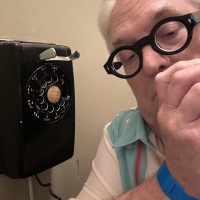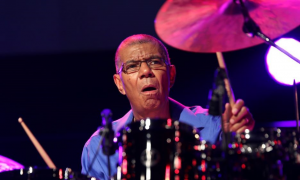Home » Jazz Articles » Big Band in the Sky » Jerry Lee Lewis: 1935 - 2022
Jerry Lee Lewis: 1935 - 2022

Courtesy Bettmann Archive - Getty Images
The era of rock & roll as popular music ended on October 28, 2022.
The last patrician of the church of rock & roll is no more. Jerry Lee Lewis died at the age of 87 at his Nesbit home in Desoto County, Mississippi on Friday morning, October 28, 2022.
Larger than life, in death, Lewis emerges a deeply divided figure: one justly praised for his unequaled artistic achievement and significance and, one vilified for his legion of human foibles. Lewis was one of the first victims of that contemporary method of cultural genocide, "cancel culture." Lewis's life and ground-level contributions to music have been addressed in the many notable obituaries following his passing. This discussion intends to focus on Lewis as part of the larger musical picture using one of the singer's most famous recordings, Live at the Star-Club, Hamburg (Bear Family, 2010).
Rock & roll music was never intended to be anything other than strutting, sneering, subversive, and dangerous. This music intended to stick its finger into the eye of a listening public growing tired of the traditional popular music of the 1940s and too complacent to change. It was music made to frighten, offend, delight, exalt, and inspire—all in the same breath. From the beginning, it had in its stable its most dedicated spokesman in The Killer.
In the spring of 1964, Lewis was entering his sixth year of artistic exile after having been "blacklisted" in response to the 1958 revelation in the British tabloid, the Daily Mail, that Lewis had married his 13-year-old cousin Myra Gail Brown, five months before his divorce from his second wife, Jane Mitcham, was official. This effectively ended both the singer's 1958 European Tour and Lewis's national and international career, relegating him professionally to constant touring and performing at smaller, less attractive, venues.
One of these smaller stages was Hamburg's Star Club, which famously hosted the Beatles at the club's opening in 1962, resulting in Live! at the Star-Club in Hamburg, Germany; 1962 (Lingasong/Bellaphon). By the time Lewis made it to the Star Club stage, backed by a British group he had toured England with, he was fit to be tied. When this recording was re-released in the 2000s, it garnered two reviews that summed up what The Killer meant to us and rock music:
Music critic Milo Miles, writing for Rolling Stone magazine, observed:
"Live At The Star Club, Hamburg is not an album, it's a crime scene: Jerry Lee Lewis slaughters his rivals in a thirteen-song set that feels like one long convulsion. Recorded April 5th, 1964, this is the earliest and most feral of Lewis' concert releases from his wilderness years, after he was banished from the radio and after he had left Sun Records for Mercury, but before he humbled himself and switched to country. Live at the Star Club is not country, boogie, bop or blues but showdown rock & roll, with no survivors but the Killer... Once Lewis launches into "Mean Woman Blues," [he leaves] the audience and his backing band, a vastly overmatched British group called the Nashville Teens, simply toast in the afterburners."
Miles provides apt imagery to the bad disposition a 29-year-old Lewis brought to the Hamburg club that night. Rather than take his social exile lying down, Lewis flexes his considerable chops, colorfully illustrating what the real meaning of rock music is: an expression of angst repressed by a prim social order expecting everything to be quaint and polite. The Killer was having none of it. He was angry and wanted everyone to know.
Later, Stephen Thomas Erlewine, writing for Allmusic, expanded on Mile's observations:
"Words cannot describe—cannot contain—the performance captured on Live at the Star Club, Hamburg, an album that contains the very essence of rock & roll. When Jerry Lee Lewis performed the concert that became this album in the spring of 1964, his career was at its lowest point. Following his scandalous marriage to his teenage cousin, he was virtually blacklisted in the U.S., and by 1964 it had been six years since he had a real hit single, he was starting his recording career again with a new label, and, to make matters worse, America had fallen in love with the Beatles and the bands that followed in the British Invasion, leaving him exiled from the charts. Ironically, he wound up in the Beatles' old haunt of the Star Club in Hamburg, Germany, in the spring of 1964, backed by the Nashville Teens, who still had yet to have a hit with "Tobacco Road" (which would scale the charts later that year). Lewis and the Nashville Teens had been touring throughout the group's native England for about a month, capped off by a stint at the Star Club, where the band played for two weeks, but was only joined by the Killer for one night, which was what was captured on this incendiary recording. Who knows why this was a night where everything exploded for Jerry Lee Lewis? It sounds like all of his rage at not being the accepted king of rock & roll surfaced that night, but that probably wasn't a conscious decision on his part—maybe the stars were aligned right, or perhaps he just was in a particularly nasty mood. Or maybe this is the way he sounded on an average night in 1964.
In any case, Live at the Star Club is extraordinary—the purest, hardest rock & roll ever committed to record... One of the profound pleasures of this record is hearing the band try to run with Jerry Lee, which is exceeded only by the sheer dementia of the Killer's performance; he sounds possessed, hitting the keys so hard it sounds like they'll break, and rocking harder than anybody had before or since. Compared to this, thrash metal sounds tame, the Stooges sound constrained, hardcore punk seems neutered, and the Sex Pistols sound like wimps. Rock & roll is about the fire in the performance, and nothing sounds as fiery as this; nothing hits as hard or sounds as loud, either. It is no stretch to call this the greatest live album ever, nor is it a stretch to call it the greatest rock & roll album ever recorded. Even so, words can't describe the music here—it truly has to be heard to be believed."
..."it truly has to be heard to be believed." That is both the essence of rock & roll and the molten center of Jerry Lee Lewis.
There has been much recent discussion among music writers, critics, and fans, debating exactly when the era where rock music was the "popular" music ended. Well, that's easy. The era of rock & roll as popular music ended on October 28, 2022.
Tags
PREVIOUS / NEXT
Support All About Jazz
 All About Jazz has been a pillar of jazz since 1995, championing it as an art form and, more importantly, supporting the musicians who make it. Our enduring commitment has made "AAJ" one of the most culturally important websites of its kind, read by hundreds of thousands of fans, musicians and industry figures every month.
All About Jazz has been a pillar of jazz since 1995, championing it as an art form and, more importantly, supporting the musicians who make it. Our enduring commitment has made "AAJ" one of the most culturally important websites of its kind, read by hundreds of thousands of fans, musicians and industry figures every month.
























